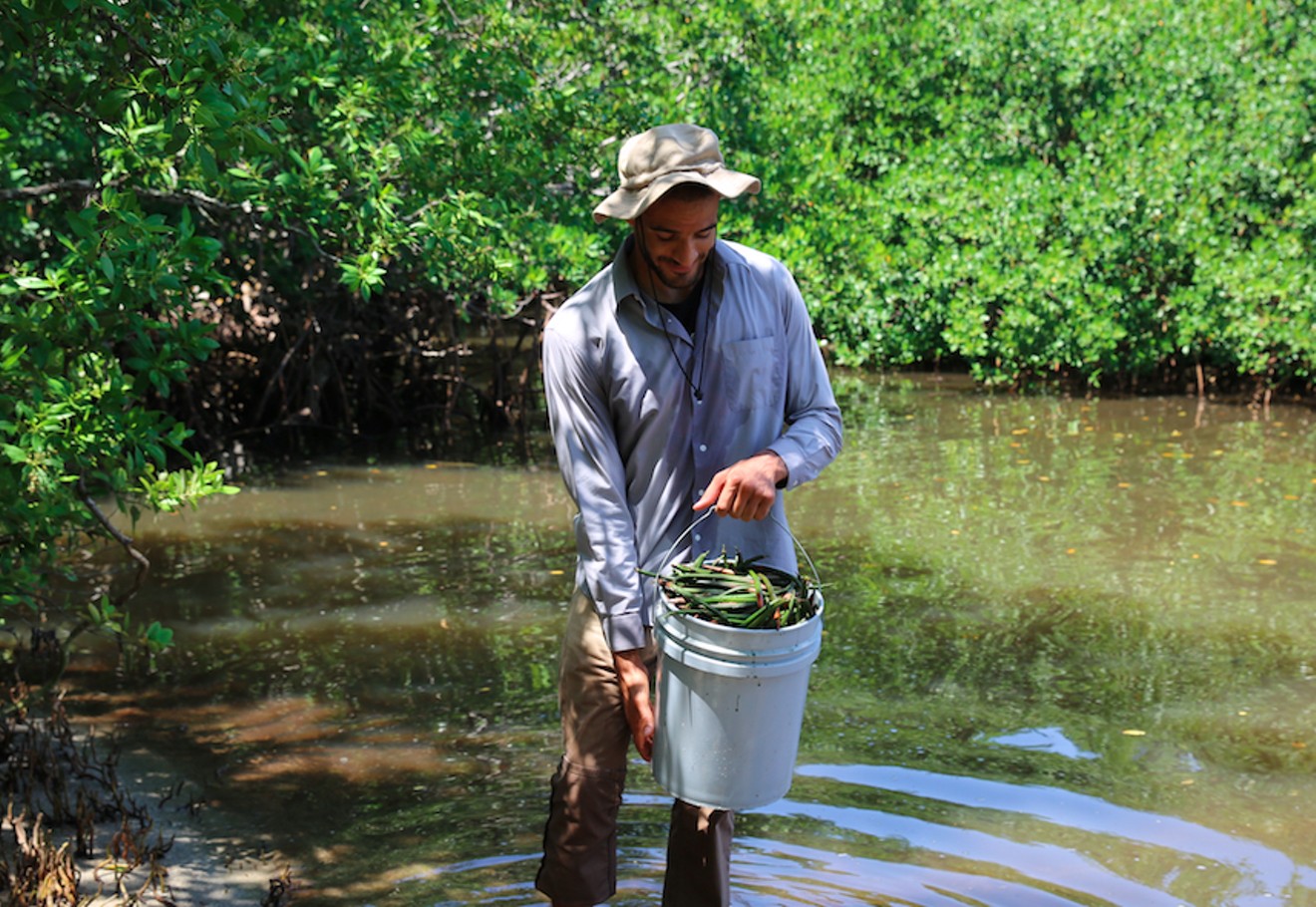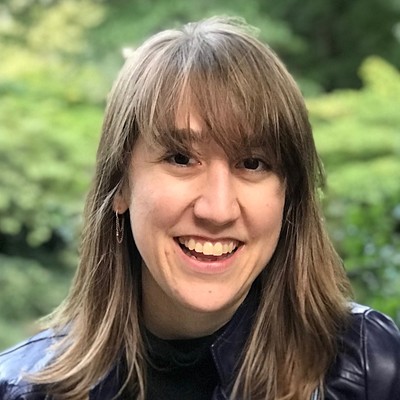From street flooding after summer rainstorms to king tide deluges in Miami Beach, the effects of sea-level rise are already being felt in Miami-Dade. But artist Xavier Cortada doesn’t want Miamians to panic: Instead, he wants them to be educated and prepared. That’s why, as part of his latest project, "Plan(T)," he’s asking Magic City residents to plant salt-tolerant mangrove trees on their properties.
This is far from Cortada’s first time using his work to draw attention to the effects of climate change. He’s spent more than a decade incorporating mangroves into his art, and many of his other projects involve climate science and the natural world.
“As an artist, I use science as a muse,” he says, “and I try to communicate that in innovative ways that help folks better understand how they can problem-solve.”
A Miami native, Cortada holds an undergraduate degree in psychology, with minors in biology and chemistry, from the University of Miami. After graduating, he earned degrees in both business and law and began engaging with community organizing. His work took him all over the world, from working with kids in postapartheid South Africa to painting murals with children on the streets of Bolivia. “I found this beautiful language of art, a language that had personally helped me as I was coming out as a gay man,” he says. “I remember using art as a way of navigating through that, of trying to address issues important to me, and I thought that this was a perfect vehicle to help communities and amplify their voices.”
His first experience planting mangroves came after the expansion of an 18-mile stretch of highway between Miami and the Keys. “I understand that we needed to expand it so we could stop head-on collisions and to ensure that people fleeing a hurricane had two roads out,” Cortada says. “But I thought to myself, In the future, people driving on this 18-mile stretch are going to imagine that this was always here, that we didn’t destroy 18 miles' worth of mangroves and ecosystems.” That made him think about the wildlife-rich barrier islands that had been paved over to create South Beach. For his first participatory eco-art installation, Cortada asked volunteers to collect 2,500 mangrove propagules from nature preserves and place the small plants in water-filled cups attached to modernist grids.
The growing seedlings were presented at the Bass Museum of Art in 2006 and later adopted by stores and businesses all over South Beach, reclaiming an area where mangroves can no longer thrive on their own because of seawalls and development.
“That was my way of making the invisible visible,” Cortada says. It became the beginning of the Reclamation Project, which Cortada has continued for the past 12 years in partnership with the Frost Museum of Science. Expanding the project to various locations, they've engaged volunteers and schools to help create the vertical nurseries and, when the seedlings have grown enough, to plant them on Virginia Key or Key Biscayne.
This year, though, Cortada wanted to do something a bit different. “Saltwater intrusion is damaging our native tree canopy,” he says. Many of Miami’s trees need freshwater to grow and thrive. As sea levels rise, saline water will infiltrate the groundwater in the aquifer below our feet, and over time, freshwater-loving trees will find it more difficult to survive.
Unless it's contained, saltwater intrusion can also lead to contaminated drinking water, damage to septic tanks, decreased property values, stronger hurricanes, and climate migration, to name just a few consequences.
This is where Cortada’s campaign comes in. Mangrove trees are saltwater plants that thrive at the water’s edge. “Visually, I was trying to create the future,” he says. “I was trying to have you imagine your backyard as a place that could only host salt-loving, salt-tolerant trees, and, more important, I wanted you to imagine what your life would be like when the six-inch seedling that I gave you was a full-grown tree.” As the mangrove trees grow, they’ll be everyday reminders that Miamians should prepare themselves for major changes to come.
The mangroves will create shade, sequester carbon, and buffer against storms and flooding. But Cortada hopes they’ll also start conversations among neighbors. With each mangrove propagule, he’s also giving out a white flag to be planted in the ground next to the growing tree. Participants can look up the elevation of their property and write it on the flag (a big number “6” for six feet above sea level, for example). “These little white flags let you begin to map the topography of Miami-Dade County,” Cortada says. “And knowledge is power. I want people to be in power to make the right choices for the rise in their communities.”
Cortada stresses he hopes his project will empower, not scare, them to take action. “As sensationalist as some of this stuff may sound, I don't want our community to treat it that way. In fact, I think that paralyzes us,” he says. “I do this because I believe in our species. I believe in our humanity. I believe in our love for one another and our ability to effectuate change.”
To participate, there are a few ways residents can get their own seedlings. Every Sunday from 9 a.m. to 2 p.m. through January 12, Cortada and several of his UM students will host a farmers' market outside his studio at Pinecrest Gardens, where he’s an artist-in-residence. Participants can pick up a free seedling and flag, ask questions, and look up their property’s elevation using an app from Eyes on the Rise, a student journalist-driven project specializing in environmental impacts related to sea-level rise. All 50 branches of the Miami-Dade Public Library System will also give out plants on specific days, culminating in an all-libraries event January 11, 2020. Pinecrest Gardens' Hibiscus Gallery will also host an exhibit where guests can learn more about Cortada’s work and see a wall of the mangrove propagules. Finally, for this year’s Miami Art Week, Pinecrest Gardens will plant the county's first urban mangrove forest and display a mural painted by Cortada, a re-creation of one he made 15 years ago.
“At least for me, art has a way of taking something really horrible and tragic and insurmountable and adding a little hope to the equation,” Cortada says. “If I can model a creative approach to engaging others, an approach that maybe they’ll be inspired to take on themselves, then I've passed it on forward and helped model a path for a better Miami.”
"Plan(T)." Opening 7 p.m. Thursday, September 26, and then on display January 18 through February 19, 2020, in the Hibiscus Gallery at Pinecrest Gardens, 11000 Red Rd., Pinecrest; 305-669-6990; cortadaprojects.org.
[
{
"name": "Air - MediumRectangle - Inline Content - Mobile Display Size",
"component": "19274298",
"insertPoint": "2",
"requiredCountToDisplay": "2"
},{
"name": "Editor Picks",
"component": "17482312",
"insertPoint": "4",
"requiredCountToDisplay": "1"
},{
"name": "Inline Links",
"component": "18711090",
"insertPoint": "8th",
"startingPoint": 8,
"requiredCountToDisplay": "7",
"maxInsertions": 25
},{
"name": "Air - MediumRectangle - Combo - Inline Content",
"component": "17482310",
"insertPoint": "8th",
"startingPoint": 8,
"requiredCountToDisplay": "7",
"maxInsertions": 25
},{
"name": "Inline Links",
"component": "18711090",
"insertPoint": "8th",
"startingPoint": 12,
"requiredCountToDisplay": "11",
"maxInsertions": 25
},{
"name": "Air - Leaderboard Tower - Combo - Inline Content",
"component": "17482313",
"insertPoint": "8th",
"startingPoint": 12,
"requiredCountToDisplay": "11",
"maxInsertions": 25
}
]














